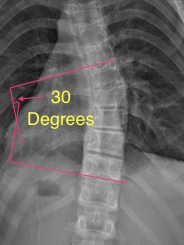The Cobb angle is an angular measure of deformity of the spine in the coronal (frontal plane). It is named after American orthopedic surgeon John Robert Cobb, who wanted to find an accurate and consistent measure for the severity of spinal deformities, in particular scoliosis.
To measure the Cobb angle you need to:
- Identify the most tilted vertebrae at the top of the curve
- Draw a line parallel to the top end plate
- Identify the most tilted vertebrae at the bottom of the curve
- Draw a line parallel to the bottom end plate
- The angle at which these lines intersect is the Cobb angle
- This can be done by extending the two lines until they meet
- Or you can draw lines at 90 degrees and measure the angle of their intersection as in the example below
For a spinal curvature to be considered a scoliosis it needs to have a Cobb angle of greater than 10 degrees. While it may appear easy to measure a Cobb angle, experience is required, one study showed up to a 7 degree error between orthopeadic surgeons. 1
Even with the same practitioner an error of around 3-5 degrees2 is normal this is why a change of at least 5 degrees from x-ray to x-ray needs to be seen to be confident that there has been a significant change (worsening or improvement) of the scoliosis.1
1 – Morrissy RT, Goldsmith GS, Hall EC, Kehl D, Cowie GH. Measurement of the Cobb angle on radiographs of patients who have scoliosis. Evaluation of intrinsic error. J Bone Joint Surg Am. 1990;72:320–7.
2 – Pruijs JE, Hageman MA, Keessen W, van der Meer R, van Wieringen JC. Variation in Cobb angle measurements in scoliosis. Skeletal Radiol. 1994;23:517–20


